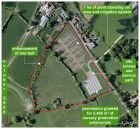Check out your property's value for development

If you are planning to retire, and your pension is not looking as robust as it was, then the value of your Garden Centre site may be your dependable nest egg. After a poor Spring, which will inevitably depress Garden Centre values, increasingly owners are looking at alternative development options for their site. The most popular is Housing. But there are others to consider, including Care Homes, Retirement Villages and Retail.
There is a growing shortage of housing, particularly affordable housing, and developers and housing associations are keenly looking for suitable sites. Many Garden Centres are located either in open countryside or Green Belt, for which there is normally a presumption against development beyond agriculture and forestry. However, the recently enacted NPPF (National Planning Policy Framework) has squarely put the ball back into the local authorities’ court by requiring them to prove that they have a Five Year Housing Supply. The supply of sites must be realistically achievable and where there has been a consistent under-delivery of housing supply by the local authority an additional 20% buffer is added to their 5-year housing supply requirements. Inevitably local authorities are loath to admit that they have a lack of housing and it may require a researched housing supply report to be produced to prove that their supply figures do not add up to a 5-year deliverable housing supply situation.
Having proven a lack of housing does not automatically mean that your site is a suitable housing site. It still needs to be able to be developed in a ‘Sustainable’ way, ‘Sustainable’ being not simply in the narrow sense of the word but including its ability not to impact adversely on the landscape, historic setting of a village etc. However, the NPPF does enable developments which previously would never have been considered for housing to be now considered. I recently was an expert witness at an appeal for a new development on the edge of a village in open countryside at which all the residents and local councillors were vociferously opposed to the development. The proposed housing was approved on appeal because there was a lack of a 5-year housing supply, and it was proven that the housing could be developed on the site without significant detrimental effect on the environment.
There are other options to consider for development as well. Sites for Care Homes and Retirement Villages in the right locations are becoming increasingly sought after. There has been much attention in the trade press given to recent supermarket developments on Garden Centres. Few Garden Centres have the size, highway access or locational requirements to meet a large Supermarket development but as the Supermarket chains are beginning to downsize and look to fill gaps in the market with smaller format stores then some Garden Centres will come into the frame as supplying such a site need. There was a recent case of a former Hurrans Garden Centre at Churchdown near Gloucester which was developed as a Tesco Convenience Store. The site area of the Garden Centre was only some 2.2 acres and the new Food Store had a net retail area of 1,071m². The site was in a built-up area and was too small to function as a modern large Garden Centre but an ideal size for a smaller format Food Supermarket.
We would normally begin our assessment of whether a site has alternative development site value by studying the planning policy constraints.
Checklist for Garden Centre Development Site Value:
- Is the Garden Centre adjacent to a settlement, or within the open countryside?
- What is the Local Plan designation? This should highlight many of the statutory designations (but will not list all of them) and will show which Local Plan policies are relevant to the development.
- Is the site within the Green Belt? If it is, can paragraph 89 of the NPPF assist (ie can development be promoted which does not impact on the five purposes of the Green Belt)? If not, are there any Very Special Circumstances which would make development of the site appropriate?
- Is the site within any areas which are afforded statutory protection (AONBs, National Parks, SSSIs etc)? If it is, will there be any potential impact? If so, consult statutory body and assess potential mitigation measures.
- Is the site in a Flood Risk Zone? If it is, which zone, and can the sequential and exceptional tests be passed? Would a Flood Risk Assessment and Drainage Strategy mitigate potential risks?
- Is the site within or adjacent to a Historic Asset? Will the site affect the setting of a Listed Building or other historic asset such as a Conservation Area or Scheduled Ancient Monument? If it is, assess potential impact and mitigation measures, and consult local planning authority’s Conservation Officer
If the answers to the above short checklist are positive, there is scope for further research. If you are a member of the HTA, remember that we are the official town planning consultants to the HTA and offer a free advice line for an informal discussion. We can help you bottom out the chances of lodging a successful planning application and increase the value of your site.
For further information contact:
MALCOLM SCOTT
Email: malcolms@malcolmscottcons.co.uk
Phone: 01905 726353
Web: www.malcolmscottcons.co.uk

